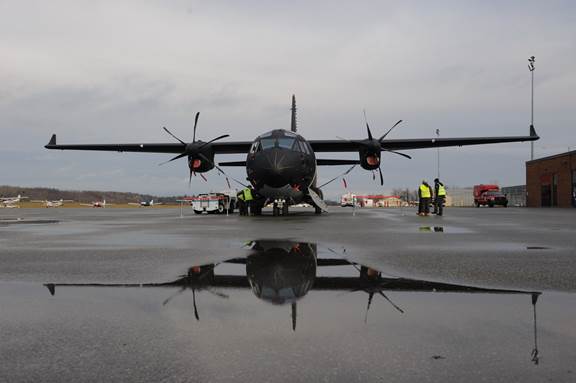
GATINEAU, QUÉBEC – Taking advantage of the gathering of the Canadian aerospace industry in Ottawa on November the 15th and the 16th at the occasion of the annual Canadian Aerospace Summit organized by the Aerospace Industries Association of Canada (AIAC), Team Spartan invited the media to the Gatineau-Ottawa Executive Airport (CYND) to come closer to a brand new Leonardo (formerly known as Alenia and Finmeccanica) C-27J at the end of the Summit on the 16th between 3pm and 5pm.
Last year, on December, the 11th, Team Spartan Canada brought for a three hour stop and a press conference, a Peruvian Air Force C-27J Spartan to the Gatineau-Ottawa Executive Airport on its way to Peru.
All this is made in the context of the Royal Canadian Air Force Fixed Wing Search and Rescue (FWSAR-ARSVF) competition aiming to replace six aging De Havilland CC-115 Buffalo based in Comox, British Columbia and fourteen Lockheed CC-130H Hercules based in Winnipeg, Manitoba (4), Trenton, Ontario (4) and Greenwood, Nova Scotia (3). This process which began more than ten years ago aims to replace these two fleets of aircraft in service for more than 50 years.
The deadline to submit bids to Publics Works and Government Services Canada (PWGSC) to supply the Royal Canadian Air Force (RCAF) with new fixed-wing search and rescue aircraft was January, the 11th, 2016. Three manufacturers have submitted bids:
Leonardo with the Italian-built twin turboprop C-27J
Airbus with the Spanish-built twin turboprop C295W
Embraer with the Brazilian-built twin turbojet KC-390.
The cost of the FWSAR program is set at 3,1 billion Canadian dollars including a 20-year maintenance contract.
The winner will be announced by the Government of Canada before the end of this year or at the beginning of next year.
The displayed aircraft on a demonstration flight en-route to South America featured FWSAR platform upgrades which include winglets improving the aerodynamics of the aircraft.
Members of Team Spartan at this event, Steve Lucas, former RCAF Chief of Staff and spokesperson of Team Spartan and Alessandro Scaburri, Leonardo C-27J demo pilot were there available to discuss the capabilities of this aircraft and the economic benefits to Canadian industrial partners that make up the team and to answer to journalists questions.
The Italian Ambassador to Canada, Gian Lorenzo Cornado attended the event.
According to Steve Lucas, ‘Team Spartan’s C-27J not only meets all of Canada’s search and rescue requirements, but in many cases also exceeds our country’s needs with its rapid response time, excellent endurance and superb maneuverability that make it ideal for Canada’s remote, austere and mountainous regions. We have a Canadian team that will bring economic opportunities to all regions in Canada, while also fitting within the existing budget’.
The ability to quickly locate and accurately deliver well equipped first responders to those in need is often the difference between life and death in the context of the vast reaches of Canada SAR area of responsibility were speed is critical to save lives.
‘That is why Team Spartan’s fully missionized C-27J, being the fastest aircraft in its category (325 Kts vs. 260 Kts of its direct competitor), is the preferred solution for the FWSAR requirement’ according to Mr. Lucas. He added that ‘Over longer missions the significant speed difference assists the C-27J to arrive and respond up to hours before its competitor. For those in the most critical of situations that time difference is vital’.
According to the Italian aircraft manufacturer, the C-27J Spartan has the capability to replace two very different FWSAR platforms, the CC-115 Buffalo and the CC-130H Hercules, which are currently in service today and reaching the end of their service life. The C-27J offers the lower speed/high maneuverability and the rugged characteristics of the CC-115 Buffalo and the speed and long range/endurance of the CC-130H Hercules.
According to Leonardo, if a rescue mission is called out at the 51°N 30°W, in the middle of the Atlantic and at the extreme of the Canada’s SAR zone, the twin-engine turboprop C-27J can perform the same mission as the four-engine tactical turboprop tactical military transport aircraft Lockheed Martin CC-130H Hercules with comparable radius of action and total mission time up to ten hours but at significantly lower acquisition and operational costs.
Steve Lucas wrapped up his presentation underlying that ‘With a fully missionized C-27J as Canada’s new FWSAR aircraft there will be no gaps in Canada’s SAR capability and no reduction in capacity at the extreme of the SAR area, mid-Atlantic and Far-North. A mission impossible for other twin engine prop aircraft’.
In its proposal, Team Spartan’s FWSAR solution comes with a commitment to deliver 100% of contract value industrial offsets and benefits in the form of hundreds of long-term jobs and far-reaching investments in Canadian firms and technology.
Team Spartan is comprised of Leonardo that will serve as the prime contractor and will provide the green aircraft platform, including engineering support and avionics, General Dynamics Mission Systems–Canada, will act as the team’s mission system integrator, responsible for modifying the aircraft and integrating high tech sensors and the computers that manage them and will serve as the in-service support (ISS) integrator for the C-27J; DRS Technologies Canada, IMP Aerospace & Defence; KF Aerospace; Esterline CMC Electronics; Rolls Royce Canada; Standard Aero; Bluedrop Training & Simulation; L3 WESCAM; TRU Simulation + Training; ATCO Structures and Logistics and FLYHT Aerospace Solutions Ltd.
The FWSAR C-27J will be modified, missionized, and supported in Nova Scotia at IMP Aerospace.
In date of last June, more than 82 C-27J had been delivered to the military forces of Italy, Greece, Bulgaria, Lithuania, Romania, Morocco, Mexico, Australia, Chad, Peru, Slovak Republic, an undisclosed African customer as well as the US Army Special Operations Command and the US Coast Guard.
Diplômé universitaire en histoire, journalisme et relations publiques, en 1993, Philippe Cauchi amorce une carrière de journalisme, analyste et consultant en aérospatiale. En 2013, il fonde avec Daniel Bordeleau, le site d’information aérospatial Info Aéro Québec.
Commentaires